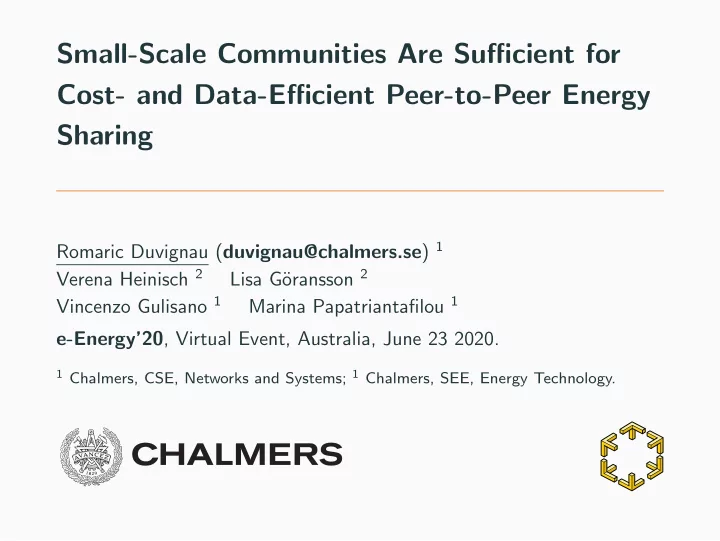

Small-Scale Communities Are Sufficient for Cost- and Data-Efficient Peer-to-Peer Energy Sharing Romaric Duvignau ( duvignau@chalmers.se ) 1 Verena Heinisch 2 oransson 2 Lisa G¨ Vincenzo Gulisano 1 Marina Papatriantafilou 1 e-Energy’20 , Virtual Event, Australia, June 23 2020. 1 Chalmers, CSE, Networks and Systems; 1 Chalmers, SEE, Energy Technology.
Introduction
Introduction: Context & Motivation + - • ? • + - • + - • • • 1
Introduction: Context & Motivation + - • ? • + - • + - • • • 1
Introduction: Context & Motivation + - • ? • + - • + - • • • 1
Introduction: Research Questions Research Questions 1. Cooperation: to understand which configurations lead to noticeable cost savings. 2. Capacity: to identify ranges of sizes for energy production, where cooperation becomes interesting. 3. Size: to identify from which community sizes the gain starts to become important. 2
Introduction: Contributions Contributions • Forecast Range : replace perfect foresight by limited prediction (online decision-making problem). • Community Compositions: use different local generation and storage capacities. • Gain-sharing Mechanisms: show how to split the cooperative gain (average financial advantage of cooperating). 3
Model
Optimization Model Individual • Objective: minimize yearly electricity bill of each household h . • Parameters for h : • PV and Battery capacities. • Hourly consumption. • Parameters for all: • Solar profile. • Electricity prices. Cooperative • Same as individual but with aggregated consumptions , generation and storage capacities. • Assumptions: no battery degradation, transmission losses nor constraints on connection capacities or communication faults. 4
Our case study: 100 households • Dataset: consumption for 100 swedish households with wide range of consumption (0.33-3.36 kWh average consumption). • Production levels: • ALR (Array to Load Ratio) : controls PV panels size. • BDR (Battery to Demand Ratio) : controls Battery size. 5 Scenarios, avg. # PV (min-max): 3500 Yearly Electricity Bill (€/year) 2500 1. Very Small – 3 PVs (1-6) 1500 500 2. Small – 9 PVs (2-17) None Very Small Small Medium Large Very Large 200 Average Saving including Investment (€/year) Medium 150 3. Medium – 18 PVs (3-33) Small Large 100 Very Small Very Large 50 4. Large – 27 PVs (5-50) None 0 −50 ALR = 0 ALR = 1.5 ALR = 4.5 ALR = 9 5. Very Large – 36 PVs (7-67) ALR = 0.5 ALR = 3 ALR = 6 ALR = 12 0 5 10 15 Battery-To-Demand-Ratio (ALR,BDR): Very Small (0.5,1), Small (1.5,2.5), Medium (3,5), Large (4.5,10), Very Large (6,15). 5
Results
Result 1. We need pure-consumers as well! 300 Avg Coop. Gain (€/household) 0% prosumers 25% prosumers 250 50% prosumers 200 75% prosumers 100% prosumers 150 100 50 0 0 1 2 3 4 Average ALR of the 100-Community Avg. Rel. Coop. Gain (€/Household) 0.10 Very Large Large 0.08 Medium Small 0.06 Very Small 0.04 0.02 0.00 0 10 20 30 40 50 60 70 80 90 100 6 Number of Equipped Household (over 100 Households)
Result 2. Small-scale communities are enough! 175 Avg. Coop. Gain (€/household) Very Large Large Medium Small Very Small 150 125 100 75 50 25 0 100/100 1/5 1/4 1/3 1/2 2/4 2/5 4/10 10/25 20/50 40/100 Size of the Community in Prosumers/Total (2-100 peers) 30 Self-Cons. (%) 20 10 100-community 100-community Small-scale com. Small-scale com. Individual Individual 0 Diff. with Ind. (%) Small-scale com. 5.0 100-community 1/22/4 2/5 3/5 2/3 1/3 3/4 1/4 4/5 1/5 2.5 2/23/34/45/5 0.0 20% 25% 33% 40% 50% 60% 66% 75% 80% 100% 7 Fraction of Prosumers in the Community
Result 3. Forming the right pairs is important! 200 Avg. Cooperative Gain (€/Household) 0.4kWh 1.9kWh 1.1kWh 2.1kWh 1.3kWh 2.2kWh 1.4kWh 2.5kWh 150 1.8kWh 2.9kWh 100 50 2 4 6 8 10 12 14 16 Generation power of the paired Prosumer (kWp) Avg. Coop. Gain (€/household) 10/20 pairing 20-com. 100% 99% 150 10/100 pairing 100-com. 125 75% 100% 71% 96% 96% 95% 100 88% 80% 75 41% 39% 50 25 0 Random Worst Best Greedy-Largest Greedy Single Community 8 Pairing of 10/20 and 10/100 prosumer/consumer households
Result 4. We don’t need much prediction power! 1.0 Fraction of optimal saving 0.8 0.6 Optimal Solution 0.4 Greedy Individual Truth Predictor 0.2 Average Predictor Linear Predictor 0.0 0 10 20 30 40 50 Number of forecasted hours Avg. Coop. Gain (€/household) Perfect Foresight Truth Predictor Average Predictor 100 Linear Predictor Greedy Coalition 50 0 2 4 6 8 10 12 9 Generation power of the paired prosumer (kWp)
Result 5. Consumers should also get rewarded! No-Split Even-Split Max Avg. Coop. Gain For Prosumers 600 1/2-Split Individual 3/4-Split 400 200 Max Avg. Coop. Gain 125 100 For Consumers 75 50 25 0 1 2 3 4 5 6 ALR (Production Level) for Prosumers in the community 10
Conclusion
Take Home Messages 1. Small-scale communities obtain up to 88-97% of the same benefits of any larger community → large reduction in the amount of data to share over the network! 2. Matching prosumers with pure-consumers in the right way can lead to up to 59% improvement on the coop. benefit! 3. No need for very accurate predictions: you can achieve up to 90% of the optimal cooperative gain with inaccurate and limited foresight of only 8h, and 96% with 16h! 4. How the gain is split among the peers influence motivations both on investing in energy resources and participating in the sharing process! • Future Work: Can we organize households (matching problem) into a data- and cost-efficient P2P network in a distributed and continuous fashion ? 11
Thank you for your attention, and take care! 12
Recommend
More recommend